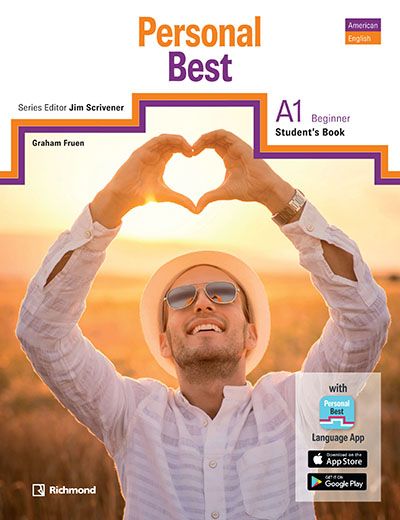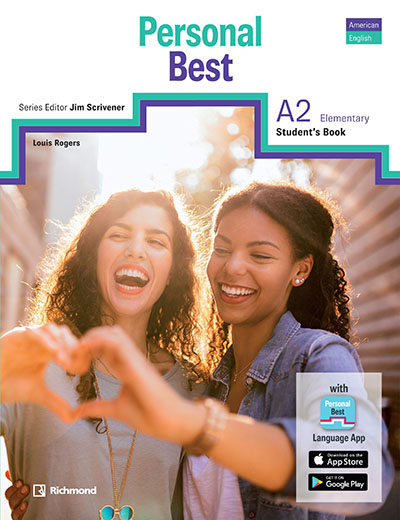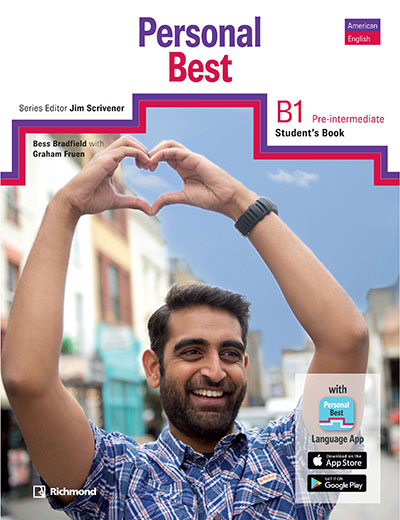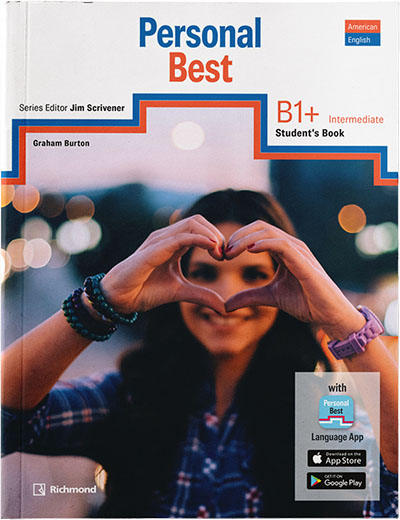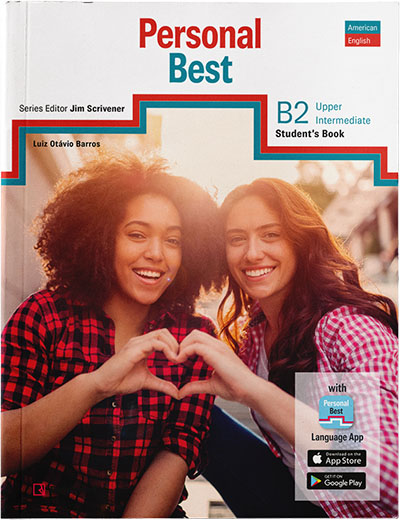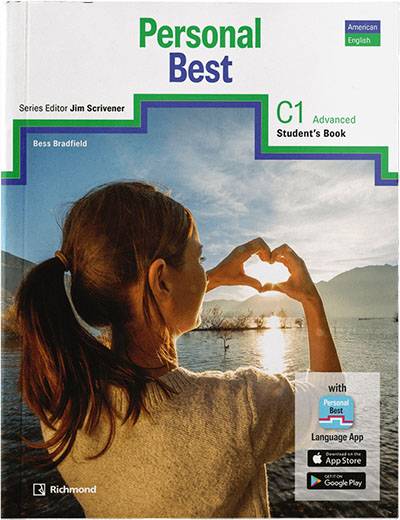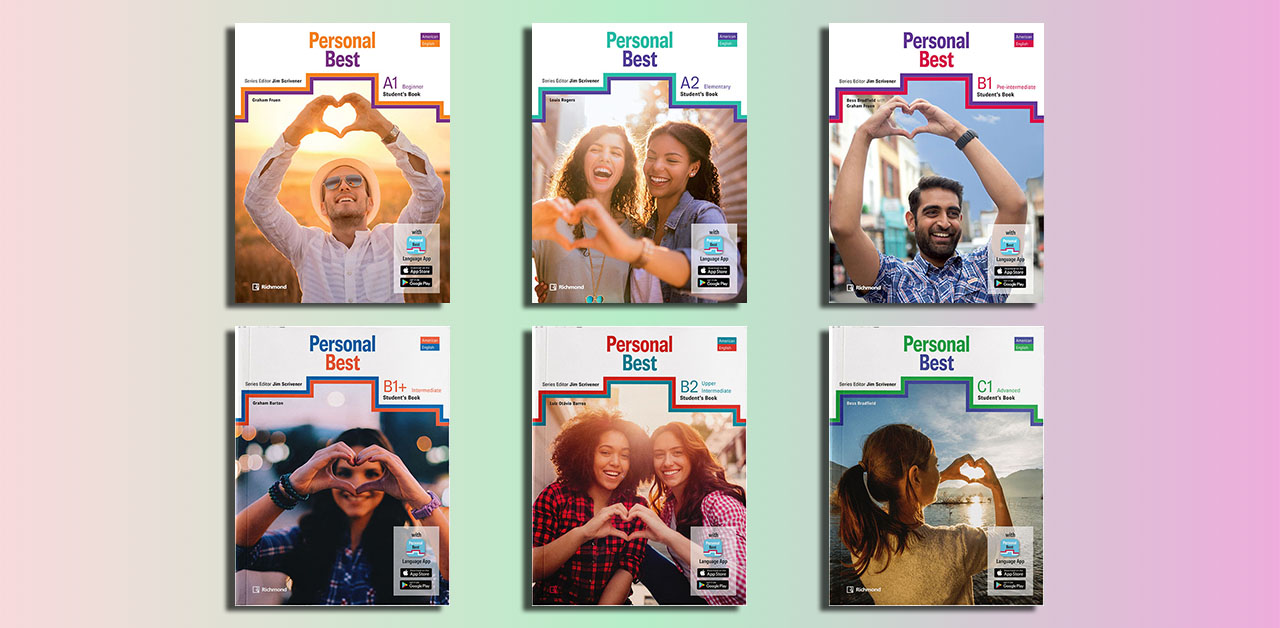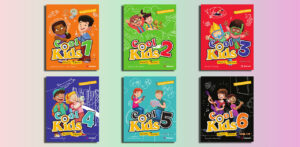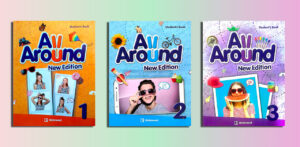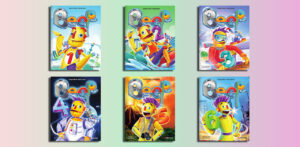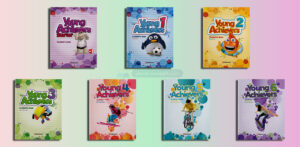Personal Best
Level 1 (A1)
Digital Book – Resources – SB Audio – Student’s Book – Teacher’s Book – Video – WB Keys – WB Audio – Workbook
Student’s Book – Sample: Click
Workbook – Sample: Click
Level 2 (A2)
Digital Book – Resources – SB Audio – Student’s Book – Teacher’s Book – Video – WB Keys – WB Audio – Workbook
Student’s Book – Sample: Click
Workbook – Sample: Click
Level 3 (B1)
Digital Book – Resources – SB Audio – Student’s Book – Teacher’s Book – Video – WB Keys – WB Audio – Workbook
Student’s Book – Sample: Click
Workbook – Sample: Click
Level 4 (B1+)
Digital Book – Resources – SB Audio – Student’s Book – Teacher’s Book – Video – WB Keys – WB Audio – Workbook
Student’s Book – Sample: Click
Workbook – Sample: Click
Level 5 (B2)
Digital Book – Resources – SB Audio – Student’s Book – Teacher’s Book – Video – WB Keys – WB Audio – Workbook
Student’s Book – Sample: Click
Workbook – Sample: Click
Level 6 (C1)
Digital Book – Resources – SB Audio – Student’s Book – Teacher’s Book – Video – WB Keys – WB Audio – Workbook
Student’s Book – Sample: Click
Workbook – Sample: Click
✅ Get Personal Best: (PDFs, Resources + Digital Book): $8 / level; $38 / all 6 levels
๏ Other payment methods: Click here
Overview of the “Personal Best” by Richmond
Contents
| ✅ Coursebook: | Personal Best |
| ✅ Publisher: | Richmond |
| ✅ Levels: | A1, A2, B1, B1+, B2, C1 |
| ✅ English type: | American English |
| ✅ For: | Adult, Young adult |
| ✅ Publication year: | 2022 |
Personal Best is a six-level General English course designed for young adult learners, focusing on maximizing their English language learning experience through extensive practice and a modern, engaging course structure. Developed with series editor Jim Scrivener, an internationally renowned teacher trainer, the course emphasizes practice as a driver of improvement and integrates 21st-century tools like a web-based video show and digital resources. It is available in both British and American English editions, covering levels A1 to C1 (Beginner to Advanced).
Key Features
Structure and Content:
- Student’s Book: Divided into 12 units with separate lessons for language (grammar, vocabulary, pronunciation) and skills (reading, listening, writing, speaking). Lessons A and C focus on language, using short, graded texts or audio for context, while B and D lessons target skills, with D lessons emphasizing productive skills (speaking or writing).
- Comprehensive Skills Syllabus: Prioritizes speaking and writing, with clear “Builder” and “Skills” boxes to highlight specific skills being developed.
- Review and Practice: Six sections (every two units) review grammar, vocabulary, and functional language through varied exercises, ending with a fun Personal Best task for productive language recall.
- 3xPractice Feature: Encourages deeper engagement with language through three-step activities that promote experimentation with forms and meanings.
- Personal Best Boxes: Provide activities for weaker students, designed for easy setup by teachers and independent work by students, with questions to check understanding.
Resources and Components:
For Students:
- Student’s Book with access to the Richmond Learning Platform.
- Workbook with practice for each lesson and additional review sections.
- Personal Best Language App (Note: The app is no longer available as of the latest updates).
For Teachers:
- Teacher’s Book with interleaved Student’s Book pages, detailed guidance, answer keys, audio/video scripts, and extra practice ideas.
- Teacher’s Resource Book with over 60 photocopiable activities for grammar, vocabulary, and skills, plus unit and end-of-term/year tests.
- Digital Book for interactive whiteboards, including embedded audio, video, scripts, and notes.
- Class Audio and Video Pack with MP3 and MP4 files, including the Learning Curve webshow.
Richmond Learning Platform: Offers extra practice activities, a forum, messaging, cloud storage, and a test management system. Teachers can track progress, assign tasks, and access resources like worksheets, audio scripts, and wordlists.
Unique Elements:
- Learning Curve Webshow: A video series filmed in New York and London, featuring British and American hosts presenting documentaries, interviews, and video diaries. Integrated into speaking or listening lessons, it uses natural but graded language to bridge classroom learning with real-world English.
- Pronunciation Syllabus: Focuses on connected speech to improve recognition and production.
- Vocabulary Emphasis: Each unit includes two or more vocabulary sets, integrated into discussions and tasks.
- Teacher Training Videos: Featuring Jim Scrivener and Bell School teachers, accessible via the Richmond Learning Platform.
Approach to Learning:
- Language Lessons (A and C): Focus on grammar, vocabulary, and pronunciation with clear, staged practice activities. Additional practice is available in the Workbook, Grammar/Vocabulary/Communication Practice sections, and the Richmond Learning Platform.
- Skills Lessons (B and D): B lessons target receptive skills (reading/listening), while D lessons focus on productive skills (speaking/writing). Lessons include Skill, Text Builder, Listening Builder, and Conversation Builder boxes for targeted skill development.
- Flexible Learning: Designed for busy young adults, the course supports self-study and on-the-go learning through its digital resources and structured practice.
Personal Best level 1 Student’s Book (A1)
Who is suitable for “Personal Best”?
Personal Best by Richmond is suitable for:
- Young Adult Learners: Designed for learners aged approximately 16–30, particularly those balancing busy schedules, as it supports flexible, self-directed learning.
- English Language Learners (A1–C1): Covers Beginner to Advanced levels, making it appropriate for a wide range of proficiency levels in General English.
- Students Seeking Extensive Practice: Ideal for those who benefit from structured, repetitive practice to improve grammar, vocabulary, pronunciation, and skills (reading, listening, speaking, writing).
- Learners Needing Skill Development: Suits students aiming to enhance speaking and writing skills, with a focus on productive skills and clear guidance through “Builder” and “Skills” boxes.
- Weaker Students: Includes Personal Best boxes with tailored activities for students needing extra support, suitable for independent or guided practice.
- Self-Study or Classroom Learners: Supports both classroom-based learning and self-study through the Student’s Book, Workbook, and Richmond Learning Platform (though the app is discontinued).
- Teachers and Institutions: Appropriate for educators seeking a comprehensive course with robust teacher resources (Teacher’s Book, Resource Book, digital tools, and videos) and a structured curriculum for young adult classes.
- Learners Interested in Real-World English: The Learning Curve webshow integrates authentic, graded English, appealing to those who want exposure to natural language use in British and American contexts.
Personal Best level 2 Student’s Book (A2)
The benefits of “Personal Best”
Comprehensive Skill Development:
- Covers all language skills (reading, listening, speaking, writing) with a strong emphasis on productive skills (speaking and writing) through dedicated lessons and Builder/Skills boxes, helping learners communicate effectively.
- Pronunciation syllabus focuses on connected speech, improving both recognition and production for clearer communication.
Extensive Practice Opportunities:
- The 3xPractice feature encourages deeper engagement with grammar, vocabulary, and functional language through multi-step activities, reinforcing learning and boosting confidence.
- Regular review sections (every two units) and Personal Best tasks consolidate knowledge with varied, engaging exercises.
Support for Weaker Learners:
- Personal Best boxes provide targeted activities for students needing extra support, designed for independent or teacher-guided practice, ensuring accessibility for diverse learner needs.
Real-World Language Exposure:
- The Learning Curve webshow, filmed in New York and London, uses authentic yet graded English in documentaries, interviews, and video diaries, bridging classroom learning with real-world communication.
Flexible Learning Options:
- Supports both classroom and self-study through the Student’s Book, Workbook, and Richmond Learning Platform, catering to busy young adults with on-the-go learning needs (though the app is discontinued).
- Available in British and American English editions, split or full editions, accommodating different learning contexts.
Personal Best level 3 Student’s Book (B1)
Robust Teacher Resources:
- Comprehensive Teacher’s Book with detailed guidance, answer keys, and extra practice ideas, plus a Resource Book with over 60 photocopiable activities and tests, simplifies lesson planning and customization.
- Teacher training videos by Jim Scrivener and Bell School teachers enhance instructional quality.
Engaging and Modern Content:
- Designed for young adults, the course uses relevant topics and a video-based webshow to maintain learner interest and motivation.
- Vocabulary-rich units with multiple sets per unit encourage practical application in discussions and tasks.
Digital Integration:
- The Richmond Learning Platform offers additional practice, progress tracking, and a test management system, enabling personalized learning and teacher oversight (requires internet access).
Structured Progression:
- Covers A1–C1 levels, providing a clear path from Beginner to Advanced, with consistent lesson structures (language and skills-focused) that build confidence and competence.
Limitations to Note:
- The discontinuation of the Personal Best Language App reduces mobile accessibility.
- Reliance on the Richmond Learning Platform may limit benefits in areas with poor internet connectivity.
Overall, Personal Best offers a practice-driven, engaging, and flexible approach that supports young adult learners in achieving fluency while providing teachers with robust tools for effective instruction.
Personal Best level 4 Student’s Book (B1+)
Effective learning strategies for “Personal Best”
To maximize the benefits of Personal Best, learners and teachers can adopt the following strategies tailored to its structure, resources, and focus on young adult English learners (A1–C1):
For Learners
Leverage the 3xPractice Feature:
- Engage fully with the three-step practice activities in language lessons (A and C). Experiment with grammar and vocabulary by completing all steps, as they build from controlled practice to creative use. Review answers in the Workbook or Richmond Learning Platform to reinforce understanding.
- Example: When practicing a grammar point like past simple, use the first step to identify forms, the second to apply them in sentences, and the third to create your own examples.
Focus on Productive Skills:
- Prioritize the Conversation Builder and Text Builder activities in skills lessons (B and D) to improve speaking and writing. Practice speaking aloud during Personal Best tasks and record yourself to self-assess fluency and pronunciation.
- For writing, draft responses for D lessons, then compare them with model answers in the Teacher’s Resources or platform to refine structure and style.
Use the Learning Curve Webshow Actively:
- Watch the Learning Curve videos (available in the Student’s Book or Richmond Learning Platform) multiple times: first for general understanding, then to note specific vocabulary or phrases, and finally to mimic the hosts’ pronunciation and intonation.
- Pause videos to repeat dialogues or answer comprehension questions aloud, simulating real-world conversations.
Regularly Review and Reflect:
- Complete the review sections (every two units) to consolidate grammar, vocabulary, and functional language. Use the Personal Best tasks at the end of reviews to apply language creatively, such as role-playing a scenario or writing a short dialogue.
- Keep a learning journal to track progress, noting challenging areas (e.g., pronunciation of connected speech) and revisiting them in the Workbook.
Utilize the Richmond Learning Platform:
- Access extra practice activities and tests on the platform to reinforce weak areas. Use the cloud storage to save notes or completed tasks for quick reference.
- Participate in any available forums to discuss topics with peers, enhancing speaking and writing in a low-pressure environment.
Practice Pronunciation Consistently:
- Focus on the pronunciation syllabus in language lessons, particularly connected speech. Record yourself practicing exercises from the Student’s Book and compare with audio files (available in the Class Audio pack or platform) to improve clarity.
- Practice minimal pairs or stress patterns daily for 5–10 minutes to build confidence in speaking.
Engage with Vocabulary Sets:
- Create flashcards or use apps like Quizlet to memorize the two+ vocabulary sets per unit. Incorporate them into daily conversations or writing tasks to ensure retention.
- Group related vocabulary (e.g., travel-related terms) and practice using them in context during Personal Best speaking tasks.
Set Personal Goals:
- Align Personal Best tasks with personal objectives, such as preparing for a job interview or travel. For example, use speaking lessons to practice relevant scenarios (e.g., ordering food or discussing hobbies).
- Track progress by completing platform tests and noting improvements in specific skills.
Personal Best level 5 Student’s Book (B2)
For Teachers
Customize Lessons for Mixed Abilities:
- Use Personal Best boxes for weaker students during class or as homework, ensuring they complete the activities independently to build confidence. For stronger students, extend tasks with open-ended questions or additional platform exercises.
- Group students by proficiency for speaking tasks in D lessons to balance participation.
Integrate the Learning Curve Webshow:
- Use the webshow as a warm-up or discussion starter. Assign pre-watching tasks (e.g., predict content based on the title) and post-watching activities (e.g., debate a topic from the video) to deepen engagement.
- Incorporate video scripts (available in the Teacher’s Resources) for detailed language analysis or role-plays.
Maximize Teacher Resources:
- Use the Teacher’s Book for lesson planning, leveraging the interleaved Student’s Book pages and extra practice ideas to adapt lessons to class needs.
- Incorporate photocopiable activities from the Teacher’s Resource Book (e.g., grammar or vocabulary games) to make lessons interactive and reinforce key concepts.
Utilize the Richmond Learning Platform:
- Assign platform activities as homework to extend practice and monitor progress through the test management system. Use analytics to identify class-wide or individual weaknesses and adjust lessons accordingly.
- Share platform resources like audio scripts or wordlists to support independent study.
Encourage Peer Collaboration:
- Pair students for Conversation Builder tasks to practice speaking in a supportive setting. Rotate pairs to expose learners to different accents and styles.
- Use group projects for Personal Best tasks, such as creating a group presentation based on a unit topic, to foster teamwork and language use.
Incorporate Teacher Training Videos:
- Watch Jim Scrivener’s teacher training videos on the Richmond Learning Platform to adopt best practices for teaching grammar, skills, or pronunciation. Apply techniques like scaffolding or error correction to enhance lesson delivery.
Balance Skills and Language:
- Alternate focus between language lessons (A and C) and skills lessons (B and D) to maintain variety. For example, follow a grammar-heavy lesson with a speaking-focused D lesson to keep students engaged.
- Use Skill and Builder boxes to explicitly teach strategies (e.g., skimming for reading, organizing ideas for writing) and check comprehension with follow-up questions.
Regular Testing and Feedback:
- Administer unit and end-of-term tests from the Teacher’s Resource Book to assess progress. Provide specific feedback on areas like pronunciation or writing structure, referencing Personal
- Best activities for improvement.
- Use platform analytics to give personalized feedback during one-on-one sessions.
General Tips
- Consistency: Dedicate regular time (e.g., 20–30 minutes daily for learners) to Workbook exercises or platform tasks to build habits.
- Engagement: Relate unit topics to personal interests (e.g., travel, technology) to make tasks more meaningful and motivate learners.
- Technology: Ensure reliable internet for platform access, as some resources depend on it. For offline settings, rely on the Student’s Book, Workbook, and photocopiable activities.
- Reflection: Both learners and teachers should periodically review progress (e.g., every two units) to adjust strategies and address gaps.
By aligning these strategies with Personal Best’s structure, learners can build fluency and confidence, while teachers can deliver engaging, effective lessons.
Personal Best level 6 Student’s Book (C1)
Alternative English Language Learning Series to “Personal Best” by Richmond
- English File (Oxford University Press): A multi-level course for adults and young adults, balancing grammar, vocabulary, pronunciation, and skills (reading, writing, listening, speaking) with engaging texts, videos, and a focus on communicative competence.
- Face2Face (Cambridge University Press): Designed for adult and young adult learners, focusing on fluency and accuracy through real-world contexts, covering grammar, vocabulary, and skills with an emphasis on speaking and listening.
- Speakout (Pearson): A comprehensive course for adults and young adults, integrating authentic BBC video content to enhance listening and speaking skills, covering grammar, vocabulary, and real-life communication.
- New Headway (Oxford University Press): A course for adult and young adult learners, combining grammar and vocabulary instruction with modern communicative activities, including reading, listening, speaking, and writing tasks.
- Cutting Edge (Pearson): A dynamic course for young adults and adults, focusing on practical language use and real-world communication, integrating grammar, vocabulary, and skills with engaging topics.
- Life (National Geographic Learning): A multi-level course for adult and young adult learners, integrating stunning National Geographic content to teach grammar, vocabulary, and skills (reading, writing, listening, speaking) with a focus on global perspectives and real-world communication.
- Outcomes (National Geographic Learning): A general English course for adults and young adults, emphasizing conversational fluency and practical language use through real-world scenarios, covering grammar, vocabulary, and all four skills.
- Navigate (Oxford University Press): A course designed for adult and young adult learners, focusing on practical English skills for work and study, with a strong emphasis on grammar, vocabulary, and integrated skills development.
- Roadmap (Pearson): A flexible course for adults and young adults, offering a modular approach to grammar, vocabulary, and skills, with a focus on personalization and practical communication for real-life situations.
- Empower (Cambridge University Press): A general English course for adult and young adult learners, combining grammar, vocabulary, and skills development with personalized learning paths and a strong focus on real-world communication.
- Language Hub (Macmillan Education): A flexible course for adults and young adults, focusing on practical language skills, grammar, and vocabulary through engaging topics and communicative activities, designed for real-life use.
- Insight (Oxford University Press): A thought-provoking course for young adults and adults, integrating grammar, vocabulary, and skills with a focus on critical thinking, cultural awareness, and effective communication.
- Open Mind (Macmillan Education): A dynamic course for young adults and adults, focusing on grammar, vocabulary, and skills development with an emphasis on life skills, critical thinking, and practical English usage.
- Skillful (Macmillan Education): A course for adult and young adult learners, focusing on academic and professional skills alongside grammar, vocabulary, and all four skills, with an emphasis on critical thinking and real-world application.
- American English File (Oxford University Press): A dynamic course for adults and young adults, blending grammar, vocabulary, pronunciation, and skills with engaging content and a strong focus on American English and communicative fluency.
- English Plus (Oxford University Press): A flexible course for young adult learners, integrating grammar, vocabulary, and skills with engaging topics, project-based activities, and a focus on building confidence in communication.
- Market Leader (Pearson): A business-oriented English course for adults and young adults, integrating grammar, vocabulary, and skills with real-world business scenarios and a focus on professional communication.
- Speak Now (Oxford University Press): A conversation-focused course for young adults, emphasizing speaking and listening skills alongside grammar and vocabulary, with engaging topics and real-life communication practice.
- World English (National Geographic Learning): A multi-level course for adult and young adult learners, using National Geographic content to teach grammar, vocabulary, and skills, with a focus on global issues and authentic communication.
- Touchstone (Cambridge University Press): A corpus-informed course for adults and young adults, blending grammar, vocabulary, and skills with a focus on conversational English and practical, real-world language use.
- Interchange (Cambridge University Press): A widely-used course for adult and young adult learners, focusing on grammar, vocabulary, and all four skills with engaging real-world topics and a strong emphasis on conversational fluency.
- Think (Cambridge University Press): A dynamic course for young adults, integrating grammar, vocabulary, and skills with a focus on real-world communication, critical thinking, and engaging, thought-provoking content.
- Business Result (Oxford University Press): A business-focused English course for adults and young adults, covering grammar, vocabulary, and skills through practical workplace scenarios and communicative activities.
- Solutions (Oxford University Press): A course for young adult learners, combining grammar, vocabulary, and skills with a clear structure, engaging topics, and a focus on exam preparation and real-life communication.
- Passages (Cambridge University Press): A course for adult and young adult learners, focusing on advanced grammar, vocabulary, and skills development with engaging topics and a strong emphasis on academic and real-world communication.
- Evolve (Cambridge University Press): A flexible course for adult and young adult learners, emphasizing grammar, vocabulary, and skills with a focus on real-world communication, student-centered activities, and digital resources.
- Life Vision (Oxford University Press): A modern course for young adult learners, blending grammar, vocabulary, and skills with engaging content, digital tools, and a focus on critical thinking and practical communication.
- Focus (Pearson): A multi-level course for adult and young adult learners, emphasizing grammar, vocabulary, and skills development with a focus on clear learning objectives and real-world communication tasks.
- Gateway (Macmillan Education): A course designed for young adult learners, combining grammar, vocabulary, and skills with engaging content and a focus on exam preparation and practical language use.
- New Total English (Pearson): A comprehensive course for adults and young adults, covering grammar, vocabulary, and all four skills with clear objectives, engaging topics, and a focus on fluency and accuracy.
- In Company (Macmillan Education): A business-focused English course for adult and young adult learners, teaching grammar, vocabulary, and skills through practical workplace scenarios and communicative activities.


